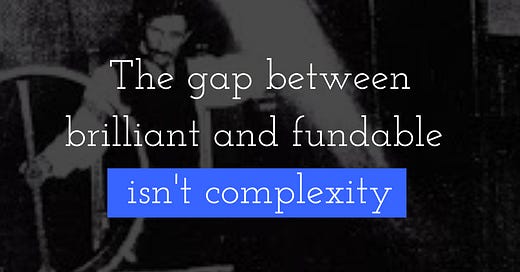Brilliant Ideas Die Because We Don't Show Them How Brilliant They Are
What Tesla's copper egg reveals about recognition
In 1887, Nikola Tesla invites his investors, Alfred S. Brown & Charles F. Peck, to his lab for a demonstration of his AC motor.
Tesla places a tin-can within the coils of his AC motor and turns it on. The tin-can spins in place like a twister. Brown thinks "what's the use of a spinning tin can?"
I know exactly how Tesla felt in that moment.
Your brilliant idea is suddenly... useless.
"I couldn't get funding to give an amputee an arm."
I had my design ready. It sat on the table in front of senior engineers, lead business development specialist, and my business line director. 12 months of research and development for 1 idea that actually makes body-powered prosthetics useful for amputees. A simple modular component that would solve 95% of issues amputees have with modern prosthetics.
I've seen upper-limb amputees struggle to do basic tasks like cooking, moving furniture, or tying shoes. The need is there.
But they didn't care. At all. I had the design right in front of them, but they couldn't see its value.
"The industry is saturated", said the business developer.
"Others can copy the design", said an engineer.
The design died. I left it, gathering dust on the shelf. It wasn't until later that I realized: my idea hadn't failed because it was flawed. It died because I couldn't make anyone see the value in the work I was doing.
They saw it as "not what we do" or "too saturated" or "not interesting". Six weeks later, they chose to move forward with a different project that cost 30% more but came with clearer client pathways and return on investment. That's when I realized: My technical superiority had lost to better business translation, and that truth sat in my chest like an anchor.
Tesla faced a similar problem.
At the time, DC dominated everything. It was efficient & powerful, and Edison was making sure it stayed ahead. He even went so far as buying rights to AC patents from Europe before they could be used in the US & giving pros and cons of the technology. He summed it up as "not worth the attention of practical men."
After the first failure of the spinning Tin can, Tesla knew he had to get more dramatic. At their next meeting, Tesla asked if they knew the legend of the Egg of Columbus.
Christopher Columbus was struggling to get financing for his voyages. Legend has it he bet his critics that he could balance an egg on its head. No one believed he could do it, but Columbus did it by standing cracking the egg lightly on one end. Queen Isabella loved it & pawned her jewels to finance Columbus's ships.
Peck & Brown knew the legend. Tesla proposed he could make an egg stand on its head without breaking its shell. He asked, "if he could go one better than Columbus, would Peck and Brown be willing to underwrite his AC experiments?"
Tesla fastened his 4-coil magnet the underside of a wooden table. He placed a copper egg on the tabletop and applied 2 out-of-phase currents to the magnet. The Egg stood on its head and spun.
From then on, Peck & Brown funded Tesla's AC work.
Showmanship.
That is the quality Tesla would carry onwards from these two demonstrations. To bring people in, you had to use metaphors, stories, and themes that have power in a particular area. It’s why you know Tesla’s name.
Tesla didn't just improve his demo. He found a story his investors already believed could change the world.
Same technology. Same room. Same investors. Different story.
Brilliant ideas die because we don't show them how brilliant they are.
Storytelling isn’t enough. Learn how to tap into emotional resonance.




